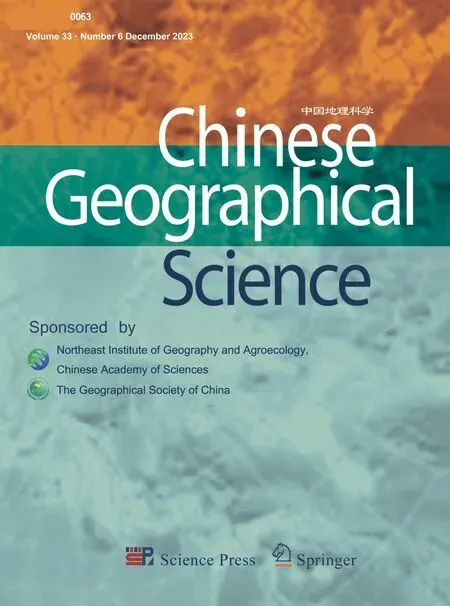Bibliometrics-based Research Hotspots and Development Trends in Ecohydrology of Dammed Rivers
2023-12-16CHENYingyiFENGMingmingSHIGuoqiangJIANGMengyuJIANGMing
CHEN Yingyi ,FENG Mingming ,SHI Guoqiang ,JIANG Mengyu,JIANG Ming
(1.Key Laboratory of Wetland Ecology and Environment,Northeast Institute of Geography and Agroecology,Chinese Academy of Sciences,Changchun 130102,China;2.University of Chinese Academy of Sciences,Beijing,100049,China;3.Changbai Mountain Academy of Science,Antu 133613,Jilin,China;4.Jilin Provincial Joint Key Laboratory of Changbai Mountain Biocoenosie and Biodiversity,Antu 133613,Jilin,China;5.Changbai Mountain Biodiversity Conservation National Long-term Scientific Research Base,Antu 133613,Jilin,China;6.College of Geographical Sciences,Changchun Normal University,Changchun 130102,China)
Abstract: Water conservation initiatives satisfy the demand for water supply,electricity generation,irrigation,and flood control.While helping humanity,they have also altered the ecosystem of natural rivers,impacted river ecology,disrupted river continuity,and jeopardized the existence of aquatic creatures in rivers.Studying the impacts of dam construction on rivers can enhance our knowledge of river ecological and environmental concerns and help sustain the health of river ecosystems,thereby realizing the harmony between humans and water in both theoretical and practical aspects.This study used bibliometrics and constructed an author-keyword 2-mode matrix network using Co-Occurrence software to identify the hotspots and research trend in eco-hydrology of dammed rivers.We identified‘FLOW’ ‘SEDIMENT’ ‘QUALITY’ and ‘MODEL’ as the research hotspots in the ecological impact of dammed rivers,and combined the related literatures,we highlight the research progress in the four directions.Then the research shortcomings and prospect were discussed,including strengthening the monitoring and analysis of critical ecological variables,enhancing the hydrological monitoring density for small rivers,strengthening the research of relationship between eutrophication and zooplankton,establishing multiscale approaches,and combining multi-sources information technologies to improve parameter accuracy in the model research.
Keywords: dammed river;eco-hydrology;bibliometrics;ecological impact;Co-Occurrence software
1 Introduction
Eco-hydrology is the study of hydrological mechanisms under changes in ecological patterns and processes,one of its important research directions is to explore eco-hydrological processes at different spatial and temporal scales and under a range of environmental conditions(Janauer,2000).Today,when ecological protection is widely considered,people gradually realize the importance of harmonious coexistence with natural ecosystems for sustainable human development.Among the many complex relationships between natural ecosystems and human beings,water is the most active and decisive link,and changes in regional hydrological processes resulting from water resource development and utilization inevitably affect the regional ecosystem.To meet water,energy,and transportation needs,humans have built more than 300 large dams (dams over 150 m high,dams with a volume of more than 15 × 106m3,or reservoirs with a storage capacity of more than 25 km3)and a large number of small dams,resulting in the fragmentation of more than half of the world’s rivers (Grill et al.,2015).In addition to fostering the development of a green energy economy (Deng et al.,2018),the construction of hydropower dams has caused a series of impacts on river ecosystems,among which the impairment of river connectivity is considered one of the main causes of many river ecological problems.Impairment of connectivity is multidirectional (longitudinal,horizontal,vertical,and temporal),and the loss of connectivity changes the natural hydrological regime and is accompanied by various ecological problems,such as the loss of native habitats of endemic species and decrease in biodiversity (Castello and Macedo,2016),damage to migratory fish populations (Hylander et al.,2006),increase in greenhouse gas emissions (Kemenes et al.,2011),and interception of suspended substances(Forsberg et al.,2017).It is estimated that 93% of the world’s rivers will be affected by dams by 2030 (Grill et al.,2015).Therefore,the verification of the ecological process evolution of river ecosystem under the impacts of dam construction and the scientific allocation of water resources,to improve the usage efficiency of water resources and protect the ecological environment,are the current research focus in the management of watersheds.
In scientific research,bibliometric methods can effectively determine the research dynamics of a certain field within a certain period and can provide a relevant scientific basis for scientific research projects and topic selection,ensure research innovation,and evaluate academic results.Co-Occurrence12.6 (COOC 12.6),a bibliometric software designed for generating various matrices and network maps,was collaboratively developed by the ‘Academic Drops’ WeChat public platform and the ‘Bibliometrics’ team from China.More information is available at https://github.com/2088904822.The software can simultaneously equipped to process literature from various databases (Web of Science,Pubmed,etc.).It excels in retrieval accuracy,efficient duplicate removal,and overall work efficiency,with a particular strength in co-occurrence analysis.At present,COOC software is extensively utilized for master’s theses (Wang,2020),intelligence analysis (Quan,2023),data mining (Gao et al.,2022),data visualization (Wang et al.,2023) and so on.In this study,we analyzed the current development of the field of eco-hydrological impacts of dammed rivers using COOC,and discussed the research hotspots and development trends in this research field.Our findings will help to keep abreast of the latest developments in river eco-hydrology research under the impact of dam construction and provides literature references for the subsequent development of the field.
2 Materials and Methods
2.1 Data
In the literature selection process,the Web of Science Core Collection database (https://www.webofscience.com/wos/alldb/basic-search) was used as the data source.The search field was set to TITLE,and the keywords used were ‘DAMS’ ‘RESERVOIRS’ ‘HYDROPOWER’‘ECOLOGICAL IMPACTS’ ‘RIVERS’ ‘HYDROLOGY’ and ‘CONNECTIVITY’.The subject areas were restricted to geography,environmental science,hydrology,earth science,biodiversity and other disciplines.The literature search was refined by choosing ARTICLE,and the language was limited to English.Moreover,to better grasp the trend and hotness of the research,this study focused on articles published from January 1st 2000 to December 31st 2021.
2.2 Data processing
Using the Co-Occurrence12.6 (COOC 12.6,China),the retrieved literature was cleaned,and duplicates and irrelevant records were removed.As this research focused on the impacts of dam construction on eco-hydrology,papers on dam construction site selection,comprehensive management assessment,dam safety scheduling,flood control,and groundwater were excluded.Conference proceedings,technical reports,and review articles were also eliminated.Finally,2693 scientific papers meeting the requirements were obtained.
Keywords are the distillation of the core content that summarizes the basic content of the paper (Guy et al.,2015).The main research direction of the author can be better understood by listing numerous keywords in the literature.In this study,we analyzed the keywords of all retrieved articles,extracted the keywords with a frequency greater than 100 times as high-frequency words(Table 1),and analyzed the research hotspots related to hydrological connectivity based on the high-frequency words.The content of articles can not be summarized by a single keyword,but by a combination of multiple keywords,and the literature in the same field often has similar keywords.Therefore,this study utilized COOC 12.6 to cluster and co-occurrence analysis the high-frequency keywords,and the results can more intuitively reflect the research themes and hotspots in the field.Cluster analysis can classify the keywords of larger data volume,trip different clustering units,so that the research theme is highly aggregated,the research level is diversified,the clustering units are closely linked,and the research direction overlap is higher.Co-occurrence analysis illustrates the high frequency of keywords through the size of nodes and centrality.The larger the centrality,the higher the frequency of keyword occurrence,the higher the heat of attention,and the more obvious the research trend and hotspot.Clustering and cooccurrence analysis can better uncover hot topics and provide a theoretical basis for the following analysis.

Table 1 High-frequency keywords (frequency greater than 100 times) and quantity in eco-hydrology of dammed rivers studies
3 Results
3.1 Post volume statistics
From 2000 to 2021,the number of English-language publications on eco-hydrology of dammed rivers studies showed an increasing trend (Fig.1),from 104 in 2011 to 478 in 2021,indicating that the ecological impact of dam construction is gradually gaining attention especially after 2011.Among these years,2020 marks the beginning of the annual explosive growth,and the number of articles in both 2020 and 2021 is 2-3 times that of the previous years.It is evident that the ecological problems arising from dam construction are now prominent,and research in this field is in a rapid development stage,which is of great significance to ecological construction.
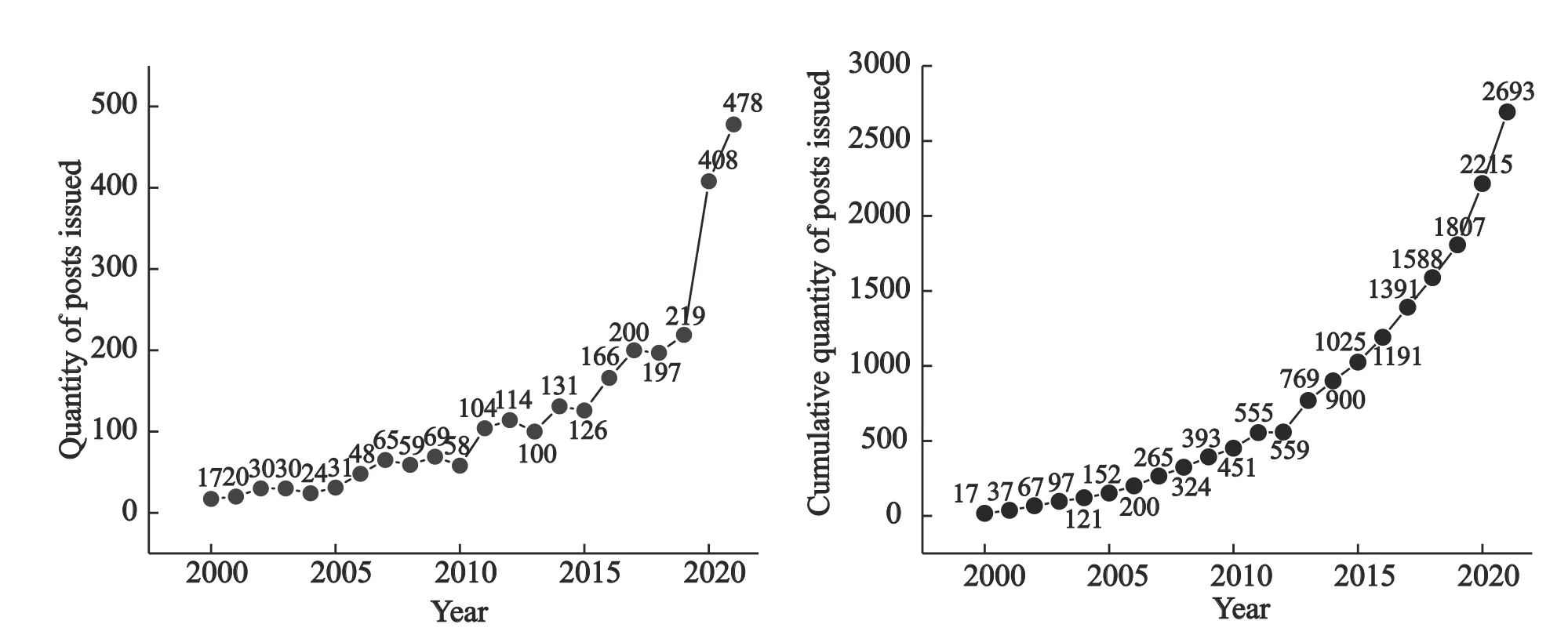
Fig.1 Schematic diagram of quantity (a) and cumulative quantity (b) of eco-hydrology of dammed river studies in 2000-2021
3.2 Analysis of research hotspots
According to Table 1,22 high-frequency keywordswere selected,which cover a wide range of subject areas such as hydrology,ecology and soil science.It includes research on various aspects such as climate change,habitat change,ecosystem diversity,water quality,pollution,management and so on.
The high-frequency keywords and author dual-tree cluster diagram were shown in Fig.2.The left side showed the author cluster statistics and the top side showed the high-frequency word cluster statistics.According to Fig.2,‘FLOW’ ‘MODEL’ and ‘SEDIMENT’appear more frequently.Zhang Q and Wang J focus in the flow direction;Wang C and Dong S K focus in the sedimentation direction;and Yang J and Gomes L C focus in the modeling direction.

Fig.2 Dual-tree cluster diagram of high-frequency keyword and author in eco-hydrology of dammed rivers studies.Frequency represents the number of times that the high-frequency words appear in the author’s research area;the first names of authors’ are abbreviated,refer to Table S1
Co-occurrence analysis allows for a more visual presentation of the author’s research area.As shown in Fig.3,the co-occurrence analysis describes the link between authors and keywords.Authors and keywords are represented as nodes in the graph.The connecting line indicates that the author and the keyword have a direct connection,which means that the keyword frequently appears in the author’s literature.The degree of association between the author and the keyword determines the thickness of the connecting line.In the visible view,the size of the nodes shows how often the word cooccurs with other keywords.The higher the frequency and the greater the keyword centrality,the larger the node will be.A connected author node indicates that both authors belong to the same research area.An author linked to a keyword node indicates that the keyword is the author’s primary research area.The keyword node is linked to indicate that the two research areas intersect.According to Fig.3,‘SEDIMENT’ ‘IMPACTS’ ‘FLOW’ ‘MODEL’ and ‘QUALITY’ showed a greater degree of centrality,reflecting hot areas of current research.Wang H,Chen L,Li Y and Yang J showed the largest centrality,indicating that these authors have provided a wide range of theories in eco-hydrology of dammed rivers.
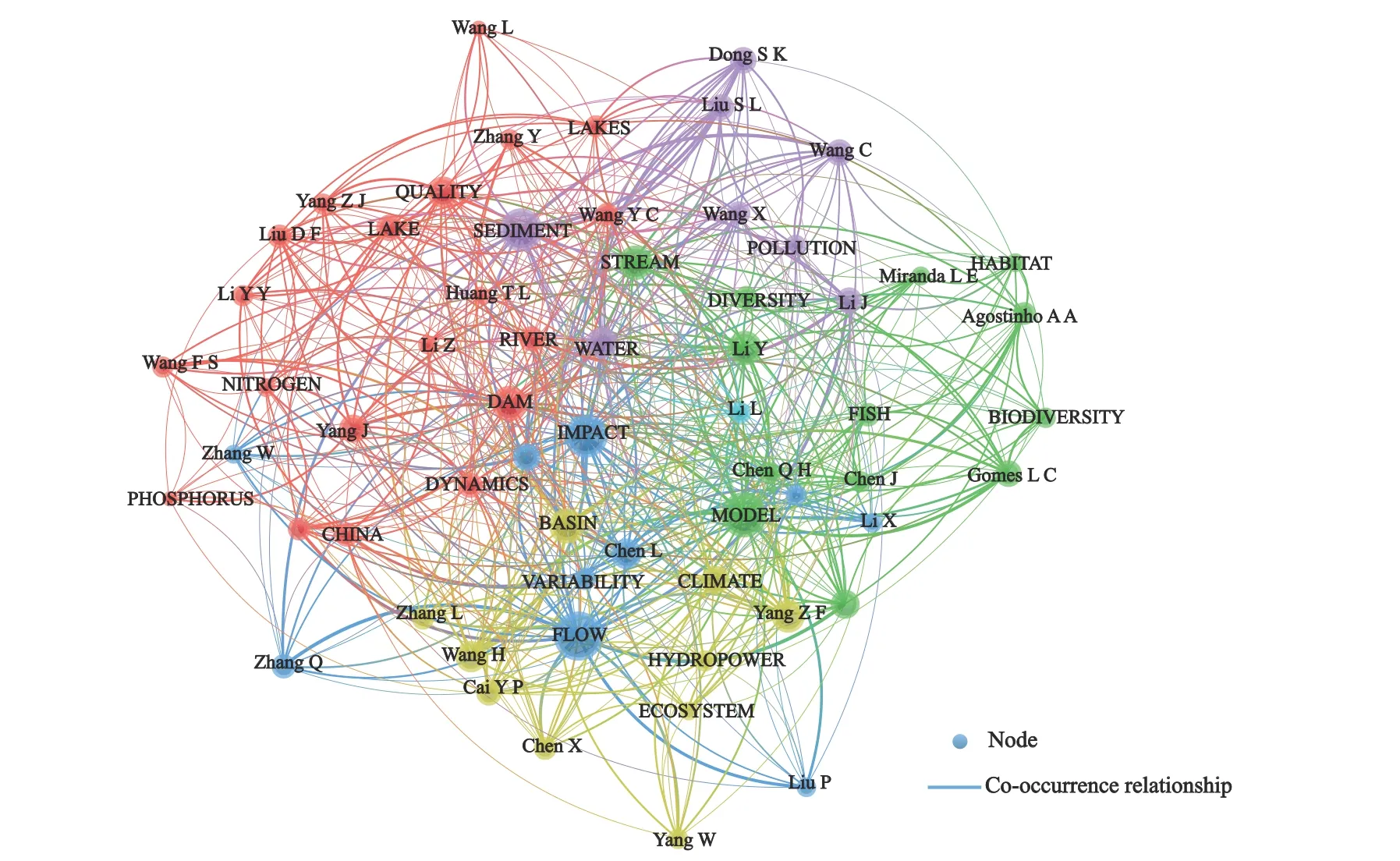
Fig.3 Authors’ research areas and partnership networks in eco-hydrology of dammed rivers studies.The thickness of the connecting line shows how often the word co-occurs with other keywords;the size of the nodes shows the keyword frequency appears in the author’s literature.The first names of authors’ are abbreviated,refer to Table S1
According to Fig.2 and Fig.3,the hotspots of ecohydrological studies on dammed rivers,the nodes ‘MODEL’ ‘FLOW’ ‘IMPACT’ ‘SEDIMENT’ ‘DAM’ ‘STREAM’ ‘BASIN’ ‘QUALITY’ and ‘WATER’ were shown more prominently.Because this study focuses on the eco-hydrological impacts of dammed rivers,the keywords ‘DAM’ ‘WATER’ ‘STREAM’ ‘BASIN’ and ‘IMPACT’ are shaved off,and the remaining ‘MODEL’‘FLOW’ ‘SEDIMENT’ and ‘QUALITY’,which to some extent represent the hot research directions that are more closely related to the eco-hydrology of dammed rivers.
3.3 The hotspots in the ecological impact of dammed rivers research
In addition to the four high-frequency keywords detailed in the article according to Fig.2,‘STREAM’ and‘BASIN’ also show larger nodes.‘STREAM’ and ‘BASIN’ indicate the size of the research area.‘STREAM’suggests that research focuses on the upstream reservoirs or downstream channels affected by dam construction,while ‘BASIN’ takes a broader view,considering the entire watershed scale.However,regardless of the scale of research,it still includes studies on river flow,sediment deposition,and water quality;the difference lies in the choice of models.Moreover,based on the fundamental research on flow,sediment,and water quality,scholars have made extensions,for example,changes in water temperature (Guo et al.,2009),responses to climate change (Chen et al.,2020),composition and distribution of nutrients (Yang et al.,2010),structure and distribution of phytoplankton communities (Winton et al.,2019),distribution of fish in river ecosystems (Ziv et al.,2012),etc..Dam construction impacts ecosystems by altering the numbers of phytoplankton and zooplankton,obstructing fish migration routes,and reducing the suitability of bird habitats,among other methods,forming an interconnected chain of impacts.This extended chain of responsive relationships has also become a future research development trend,as already demonstrated in Table 1.Based on the four hot directions derived from the clustering and cooccurrence analysis,combined the related literatures,the following section highlights the research progress in the four directions.
3.3.1 Impact of dam construction on river flow
Poff and Ward (1990) proposed that the impact of flow alterations on river flow regimes is the root cause of progressive downstream ecological degradation.The impact of dams on river flow is mainly due to the fact that humans have changed the natural flow patterns of rivers through the construction of reservoirs,dams,and other water facilities,causing natural rivers to depart from the seasonal flow patterns and creating an artificial pattern of flow variation.Dams reduce peak runoff and divide the material connection between the main channel of the downstream river and floodplain,leading to the degradation or disappearance of some species in the floodplain ecosystem (Kuemmerlen et al.,2019).Among the ecological impacts of dams,changes in flow can be considered as the basic causal factor for ecological impacts,and changes in different hydrological factors will cause corresponding ecological responses;therefore,research on river flow is relatively extensive.
The impacts of dam construction include seasonal changes in flow regimes (Bejarano et al.,2017;Kibler and Alipour,2017),and changes in water temperature owing to reservoir storage (Maheu et al.,2016).Seasonal flow variations (Bejarano et al.,2017;Kibler and Alipour,2017) and changes in water temperature caused by reservoir impoundment are all effects of dam construction (Maheu et al.,2016).The longitudinal connectivity of natural rivers is altered by dam construction,which evens the river runoff.The discharge of the Pearl River Basin of China is abnormally reduced in June and July owing to dams (Chen et al.,2010).Similar findings were reported in the Lancang River and Yellow River(Zhao et al.,2012;Yang et al.,2008).The operation of the reservoirs resulted in a decrease in the average runoff of 33% in the wet season and an increase in the runoff of 65% in the dry season,according to the research by Yang et al.(2004) on the runoff changes of two reservoirs constructed on the Yenisci River in Siberia.However,in previous studies conducted in the US,dam discharge increased during the dry season and slightly decreased during the flood season (Costigan and Daniels,2012).The focus of the investigation into how the construction of dams affects river flow change is on quantitative examination of the hydrological regimes.Hydrological regime change analysis has evolved from concentrating on the average discharge to focusing on the maximum and minimum discharges,and finally to creating an index system to adequately represent the hydrological process (Li et al.,2006).
Flow variability is the foundation of eco-hydrology research,and the impact of dam construction on river flow is the most apparent.How to effectively assess changes in river flow within a region is both a focal point and a challenge in this field.Globally,flow monitoring is more concentrated on large rivers,but there are still many gaps in the monitoring of small rivers.The author believes that the impact of dam construction,as a human intervention,is more far-reaching on small rivers.Although we now have various technical means to calculate changes in the flow of small rivers,such as model simulations,the corrections made solely based on large river monitoring data often yield unsatisfactory results.Therefore,monitoring small rivers is necessary,and assessing the impact of dam construction on the flow variability of small rivers is also challenging.
3.3.2 Impact of dam construction on river sediment
Changes in river sediment loads are important to river system function because sediment loads play an important role in material fluxes,geochemical cycles,water quality,river morphology,and the development of estuaries and deltas,affecting aquatic ecosystems and riverdependent habitats (Wera et al.,2019).In its natural state,the river system maintains a dynamic equilibrium,balancing erosion with sedimentation.The construction of dams disrupts this natural equilibrium,leading to sediment accumulation in reservoirs and decreased sediment flow downstream (Yang et al.,2005).As sediment accumulates in the reservoir,its storage capacity and power generation efficiency gradually diminish(Morris and Fan,1998).Sediment accumulation near the dam alters flow dynamics and jeopardizes its structural stability (White and Moore,2002).A high sediment content can lead to sediment deposition in reservoirs,which can also lead to sedimentation problems and changes in nutrient fluxes.Many studies have shown that sediment deposition from dams has led to significant reductions in the sediment load of many rivers,with 25%-30% of the global land-ocean sediment flux being trapped by reservoirs (Vörösmarty et al.,2003).Worldwide,dams are expected to minimize sediment transportation to the ocean by up to 24 billion t/yr (Walling,2012).The dam’s trapping effect exerts multiple influences on river ecosystems (Fan et al.,2015).Sediment trapping in reservoirs diminishes the downstream supply of streambed sediment,thereby inducing streambed erosion and modifying fluvial geomorphology (Guo et al.,2020).This reduced sediment impacts nutrient cycling and biodiversity in downstream waters (Group,2010).The interception of dams has changed the regional ecological environment,and the habits of aquatic and riparian flora and fauna in the reservoir area will cause great changes,posing a threat to the survival and development of various organisms (Forsberg et al.,2017).River deltas depend on sediments brought in by floods,and sediment trapping triggered by dam construction leads to downstream habitat erosion and loss (Giosan et al.,2014).Certain fish and invertebrates are hindered from accessing specific sedimentary habitats for reproduction and feeding (Rei et al.,2019).Moreover,dams curtail sediment delivery to coastal areas,aggravating coastal erosion and disrupting mangrove and wetland ecosystems (Yang et al.,2006).
However,quantification of sediment trapping remains controversial.In general,it is difficult to quantitatively assign the role of various drivers that lead to changes in river sediment volume,including climate change,sand mining,agricultural activities,and catchment disturbances.Precise calculation of sediment trapping by dams is also a difficult area for future research.
3.3.3 Impact of dam construction on river water quality
The loss of river connectivity is due to dam construction.As the river approaches the dam,it slows down,and the resulting reservoir becomes a hydrostatic system.Physical changes in dam construction lead to chemical changes within the reservoir,thus changing the physicochemical properties of the water,which in turn has ecological impacts on downstream rivers.
The first is the layering effect.After the formation of the reservoir,the water is divided into stable layers of different densities,and the resulting temperature difference between surface water and deep water is as high as 6°C-7°C (Magadza,2010).Vertical flow can be obstructed by suspensions and nutrient elements,which cause vertical stratification of water quality (Mao et al.,2004).Simultaneously,stratification frequently causes deep reservoir water to become deoxygenated because of heterotrophic consumption and a lack of oxygen-containing surface supplies.Nutrient changes in reservoir systems are very different from those in natural rivers(Jia et al.,2001).
The second is sediment trapping.Owing to the interception effect,after long-term operation,dams retain a large amount of sediment,organic matter,and pollutants in their upper reaches,changing the natural ecosystem state of rivers,making the water temperature and organic matter layered,the dissolved oxygen content lower,and the pH value lower,further causing eutrophication of the reservoir,difficulty in the degradation of pollutants,worsening of water quality,and numerous ecological and environmental problems,thereby threatening the survival and reproduction of biological communities,expansion of biodiversity,and richness of community structures (Zhang,2015).In addition,when water velocity decreases,hydrodynamic conditions are altered,favoring the retainment of nutrients and eventually leading to the eutrophication of water (Kunz et al.,2011).In particular,the biological community of algae is altered by the addition of extra nutrients,particularly nitrogen and phosphorus,which makes it easier for hazardous algae to grow.For instance,da Silva (2005) discovered that the cascade reservoirs in the Brazilian Iguazu River Basin in Brazil are advantageous for phytoplankton growth,causing eutrophication of water,which has a significant negative impact on the quality of the water,and globally,12%-17% of river phosphorus loads are trapped by dams (Maavara et al.,2015).Changes in the ratio of nitrogen and phosphorus fluxes play an important role in the growth and reproduction of algae in reservoirs (Akbarzadeh et al.,2019).Silicon is also effectively hidden in the reservoir and serves as an essential nutrient for phytoplankton (Nixon,2003).
However,controversy still exists regarding certain issues in contemporary studies on water quality in dammed rivers.First,dam construction has many impacts,and it is often difficult to explain which ecological factor is responsible for the change in water quality or whether multiple factors act in concert.Second,to compare the relative importance of impacts,weights must be calculated,and controversy in the calculation of weights inevitably arises.
3.3.4 Model development in eco-hydrology of dammed rivers research
With regard to the modeling of eco-hydrological processes,a certain depth of research has been conducted on eco-hydrological models,and some milestones have been achieved.Eco-hydrological models are classified according to different criteria.The model can be classified into two forms based on the spatial expression:lumped conceptual models and distributed models.Several lumped models,such as the SWIM model (Soil and Water Integrated Model) (Gao and Jin,2012),MIKE SHE model (Wang et al.,2012),Xin’anjiang model(Chen et al.,2018),and SCS model (Soil Conservation Service Hydrologic Model,Luo and Song,2011),have been developed.The lumped conceptual model reflects the overall hydrological response of the basin but does not consider the spatial heterogeneity of the basin and does not describe the physical processes of the basin hydrology;therefore,it has certain shortcomings in revealing the physical response mechanism of the basin hydrological processes.Distributed models are based on control equations described by physical processes on small-scale units for eco-hydrological simulation of basins,but the high nonlinearity of many of the control equations and the great variability of topographic features and climatic inputs to the basin make this type of model exceptionally complex and computationally difficult.As shown in Table 2,10 common eco-hydrological models and model characteristics were compiled.These models include the SWAT model (Soil and Water Assessment Tool) (Yesuf et al.,2015),RHESSys model (Regional Hydro-Ecological Simulation System)(Tague and Band,2004),Macaque model (Band et al.,2001),VIP model (Vegetation Interface Processes) (Mo et al.,2004),tRIBs-VEGIE model (Ivanov et al.,2008),and BEPS-TeminLab model (Govind et al.,2009).Hydrological model is gradual transition from lumped to distributed.The parameters of distributed models have more pronounced physical significances than those of lumped models.Distributed models account for the spatial variability of hydrologic parameters and can also address hydrologic responses at finer spatial scales.However,distributed models come with challenges,primarily because they require more parameters.This intensifies the difficulty of data collection and sensible application.
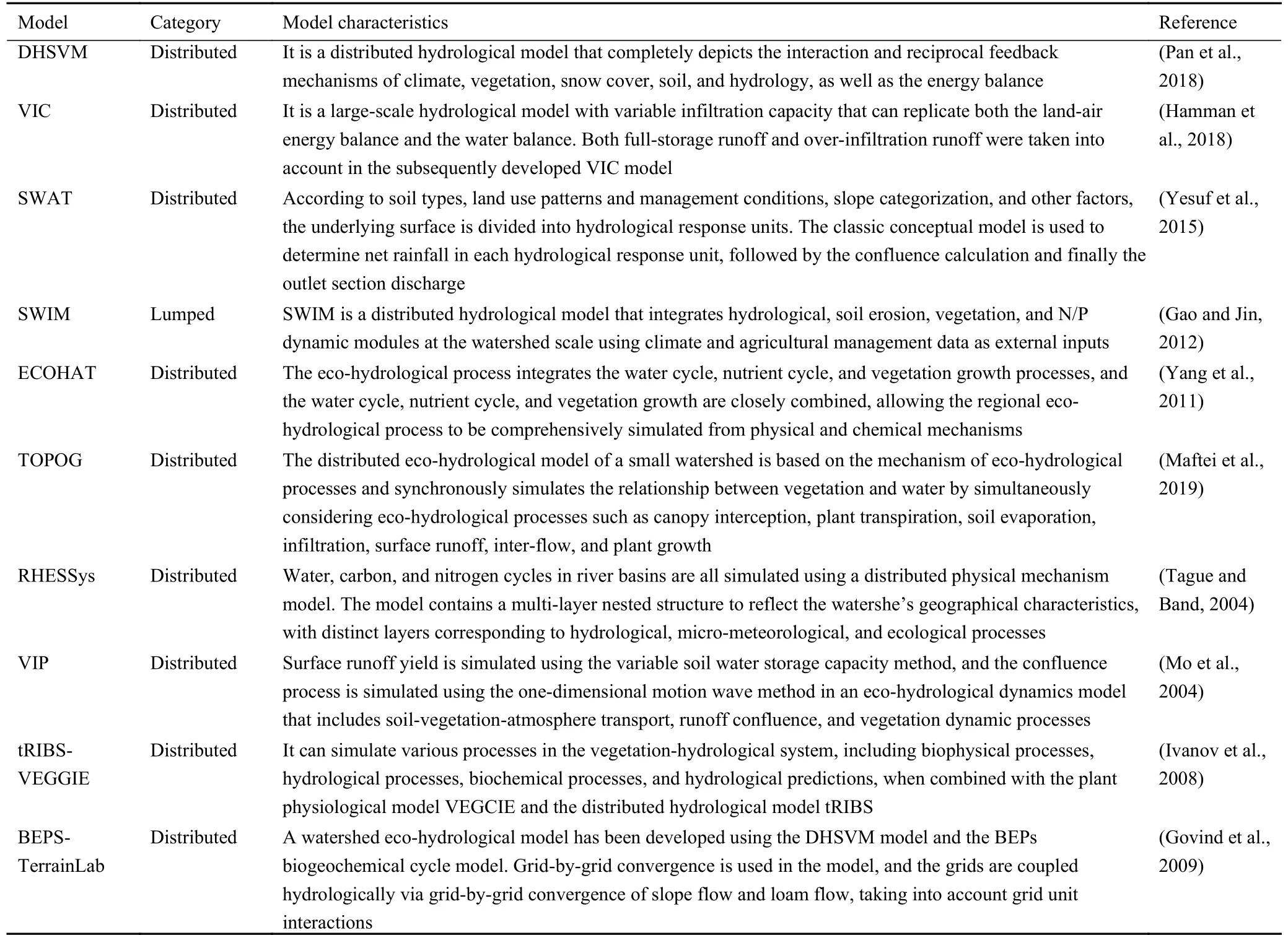
Table 2 Features of ten common eco-hydrological models
Currently,the accuracy of distributed models for watershed simulation is improving.As future model operations increasingly incorporate technologies like GIS and RS,there is a growing trend to integrate diverse information sources into the model,including watershed topography,vegetation cover,soil,and climatic factors.How to efficiently obtain and enhance the accuracy and effectiveness of these parameters represents a pivotal direction in the development of hydrological simulation for watersheds.A second concern is the issue of scale.The mechanisms underlying hydrological cycles vary across different scales,leading to diverse hydrological model structures.Addressing the spatial and temporal heterogeneity and variability of hydrological processes within the basin is central to resolving this scale challenge.Consequently,securing high-quality parameter data is essential to accurately elucidate the hydrological cycle mechanisms within the watershed.
4 Shortcomings and Prospects
There are several shortcomings in the current research:1) Flow alterations in small rivers within the basin warrant attention.These smaller rivers can be more sensitive to effects of dams compared to larger rivers.However,the monitoring and assessment of flow in small rivers remains inadequately emphasized.2) At present,the effects of sedimentation and water quality changes in dammed rivers are emerging as key areas of research.However,accurately quantifying sedimentation and water quality changes influenced by environmental factors remains challenging.3)As remote sensing technology and ecohydrological modeling advance,research methodologies and technical tools continue to evolve.Despite the efficiency of current watershed hydrological models,they possess certain limitations.For instance,lumped models may not adequately explain mechanisms,while distributed models have complex calculation processes.Achieving more accurate watershed simulations remains foundational and central to ongoing model research and development.
Based on bibliometrics,the authors summarize current research hotspots on the impacts of dams on ecosystems,and offer suggestions and prospects: 1) to as-sess the environmental impacts of dam construction,it is essential to monitor and analyze critical ecological variables.Ensuring the consistency and precision of measurement data is vital for accurately predicting future trends.2) There is a need to enhance the hydrological monitoring density for small rivers.3) For sediment and water quality research,studies should increasingly focus the relationship between eutrophication and zooplankton.4) The development of models should establish a multiscale approach,and combine multi-source information technologies such as field monitoring,remote sensing,and radar.
5 Conclusions
This study employs bibliometric methods to investigate the impact of dammed rivers on eco-hydrology from 2000 to 2021.By extracting and analyzing high-frequency words in the literatures,we explored current research hotspots and development trends in the field of eco-hydrological impacts of dammed rivers.‘FLOW’‘SEDIMENT’ ‘QUALITY’ and ‘MODEL’ emerge as high-frequency keywords,reflecting the prevailing research interests in the field.Research results in eco-hydrology for dammed rivers have surged since 2011,with the most significant spikes observed in 2020 and 2021.Based on the high-frequency keywords and associated research hotspots,we summarized the research gaps in the field of eco-hydrology of dammed rivers,including insufficient research on small rivers,difficulties in accurately quantifying sediment and water quality changes influenced by the environment,and the limitations of existing models.Based on this,we proposed future research prospects for this field.
Conflict of Interest
The authors declare that they have no known competing financial interests or personal relationships that could have appeared to influence the work reported in this paper.
Author Contributions
CHEN Yingyi: writing-original draft,investigation,methodology,software,visualization.FENG Mingming:validation and visualization.SHI Guoqiang: resources and data curation.JIANG Mengyu: writing-review &editing,supervision.JIANG Ming: conceptualization,funding acquisition,supervision.
Supplementary
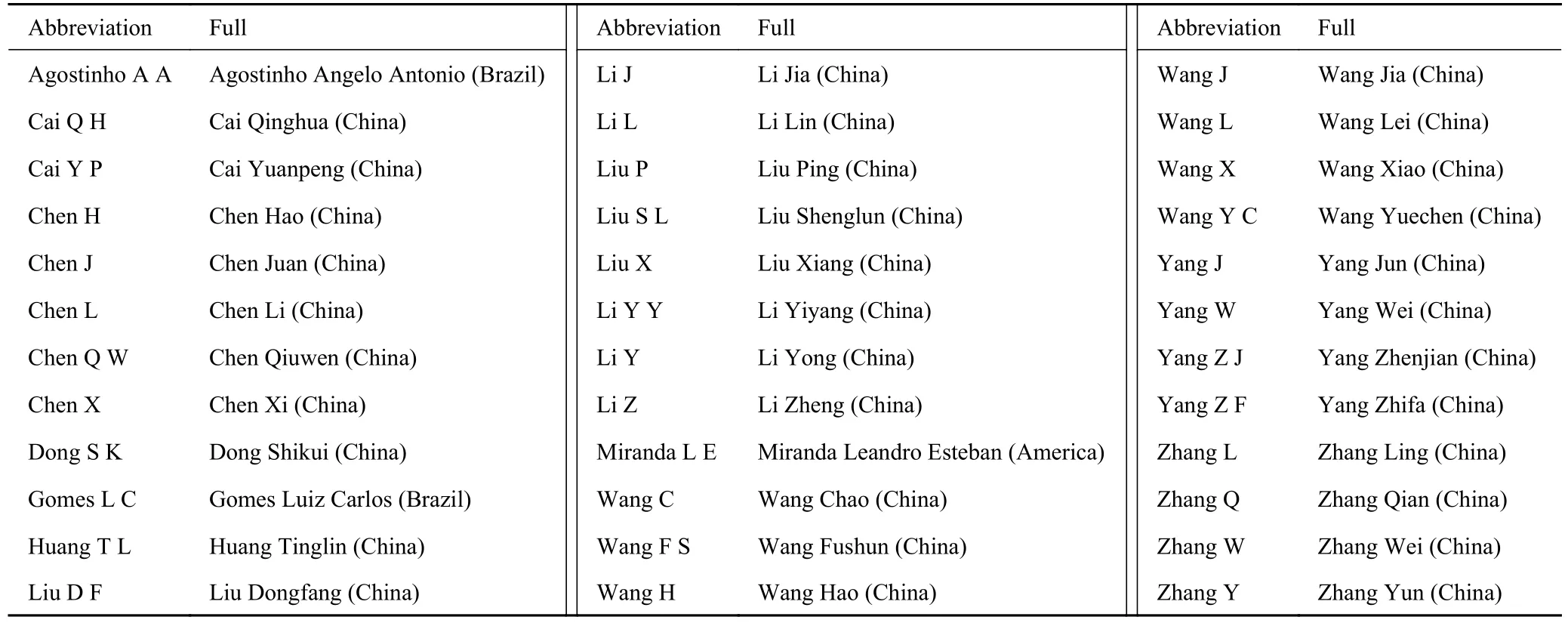
Table S1 Names of the authors in the field of eco-hydrology of dammed rivers studies
杂志排行
Chinese Geographical Science的其它文章
- Effects of Groundwater with Various Salinities on Evaporation and Redistribution of Water and Salt in Saline-sodic Soils in Songnen Plain,Northeast China
- Increasing Anthropogenic Mercury Pollution over the Last 200 Years Revealed by Lagoonal Sediments from Hainan Island,South China
- Detection of Multi-dimensional Driving Forces of Public Environmental Concern in China: Based on Spatial Heterogeneity Perspectives
- Projected Regional 1.50°C and 2.00°C Warming Threshold-crossing Time Worldwide Using the CMIP6 Models
- Spatial Distribution Pattern and Influencing Factors of Physical Bookstores of Large Cities: A Case Study of Three National Central Cities in Western China
- Leave or Stay? Antecedents of High-level Talent Migration in the Pearl River Delta Megalopolis of China: From a Perspective of Regional Differentials in Housing Prices
